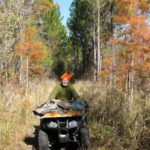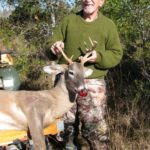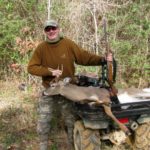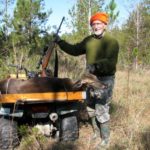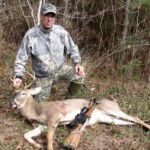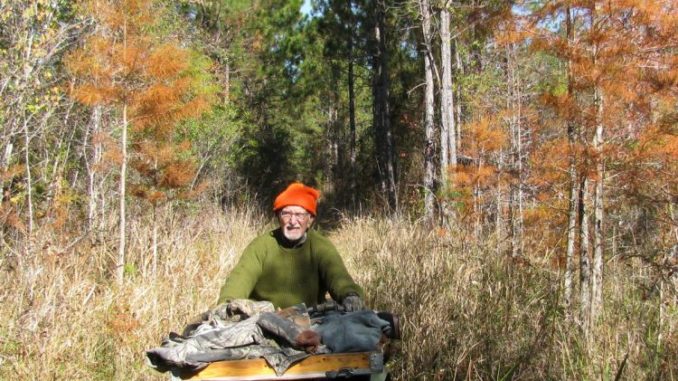
When you’re faced with piney woods thickets that deer just don’t want to leave, what are you to do? Here’s how you can turn those tangles into killing fields.
“Hunting’s for MEN!” Artie yelled, shaking his fist.
Then he turned, pointed at the tractor and plow in the shed alongside the camp, and yelled: “But farming’s for WOMEN!”
Now, Artie has never been famous for his political correctness. But the scowls, frowns and dagger-eyes he so often provokes usually issue in mixed company — a wedding reception, for instance, or a tailgate “paaaw-ty” featuring some out-of-state friends or relatives of the usual gang.
In brief: The frequent animosity to Artie’s socio-political proclamations don’t usually issue during a work detail at “Da Deer Camp” — nor from a rough-and-tumble male crowd gathered on the porch sipping brewskies, most of whom Artie has known since high school.
This was different. Artie had struck a nerve.
“Go ahead!” he continued. “Call me whatever you want — but I’m actually quoting a perfectly politically correct source!”
Spencer and Doc couldn’t help but laugh and fake-cough at this one.
“Doggone right!” Artie fired back. “Dat’s an old Native American saying! Kinda like the one about ‘vegetarian’ being on an old Indian word for lousy-hunter!” Except the farming-hunting saying is actually TRUE! Comes from Sitting Bull! Or Geronimo. Or maybe Crazy Horse. Or maybe Ten-Bears.
“Anyway, it’s from one of dem! They said the forked-tongue palefaces were forcing them to live on reservations, farming like WOMEN!…NO WAY! We’re MEN! We HUNT! So we’ll fight on before we surrender to a life like DAT!”
Spencer and Doc Fontaine had been the busiest with the tractor the past few weeks and were closest to Artie. So they finally stopped frowning and rolling their eyes, and laughing and fake-coughing — and addressed him:
“We remember you getting very busy with that tractor a few months ago,” Spencer smirked. “Or have you forgotten?”
“No, I haven’t forgotten,” Artie smirked while winking at Pelayo. “But that was last April, right before growing season. And we wasn’t plowing and planting: We was simply bush-hogging. Cutting a few lanes. Helping out that primary browse. Getting more of it to sprout at deer-browsing level.
“That’s why we did it in April. And helping us get a little better view from our stands.”
Now some of the gang inched closer. And, amazingly, they were in listening mode rather than scoffing mode.
“And we’ll be doing some more bush-hogging tomorrow — right, Pelayo?”
Pelayo nodded and did a thumbs-up with his brewskie-holding hand.
“Sure thing,” he said. “Gun season’s only three weeks away.”
Thinning the thickets
Pelayo went on to explain that this late pre-season bush-hogging would consist of making a few skinny lanes through thick brambles that don’t consist of primary browse.
“Tomorrow we’ll be cutting through some of the tall wax myrtle, youpon and elderberry thickets, making a little better view for us and a little easier walking for the deer,” he said. “Some say this spooks the deer. But, shoot, man: You oughta see the tracks on those skinny lanes just a couple days after we bush-hog em! We gotta think the smell of fresh-cut vegetation also helps attract them.
“Now back in April, back then we was bush-hogging small lanes again, so as not to turn the area into a soccer field. We definitely wanna leave it in wild condition — but we was cutting through the heavy ti-ti, greenbriar, blackberry and privet thickets. This is all primary browse in this piney woods area. So we want a bunch of it sprouting — and down low, where the deer can munch-out on it. Again, always seems to work for us. Works kinda like a natural food plot.”
Next morning Pelayo beat me to our more-or-less designated hunting area. When I found him, he wasn’t on the tractor. Instead, he was hunched over next to a stunted live oak that grew along a creek branch.
He was staring at the ground and nodding.
“Hah!” I thought to myself. “Probably found a scrape.”
We’ve noticed this the past 10 years or so in our Southeast Louisiana piney woods hunting area: a few scrapes early in the season around the opener and Thanksgiving, and then almost no fresh scrapes until the very last days of the season. Without much scraping in between.
And we’ve heard much the same from other hunters in St. Tammany, Tangipahoa, Washington parishes.
Whatever. Year in and year out, we find that — for whatever reason — deer in Southeast Louisiana’s piney woods love to scrape under the overhanging branches of low-slung live oaks.
They also gorge on those little green acorns that litter such areas every other year and provide what little mast exists in many pine plantations, outside of a few water oaks in the meager creek bottoms that are studded mostly with sweet bay and gums (that, when mature, produce no deer food).
Transition zone tips
Nearby, we found a nice rub line, mostly on pencil-thin wax myrtles and pine saplings. Many trails crisscrossed the area.
We were meandering along the border between a 5-year-old clear cut, and a gum and hardwood strip that paralleled the same creek branch.
As usual, wherever two landscapes meet we’ve noticed that deer trails appear, usually paralleling the transition zone. Many bottoms in Southeast Louuisiana timberland — though pretty — produce no deer food to speak of, being made up mostly of poplar and gums.
But these locales — and especially the tall and straight trees — make ideal sites for those of us who still favor climbing stands. Here we can face up and away from the bottom to scan the better-used trails that usually parallel the rough line where the bottomland landscape meets the piney woods landscape.
When this landscape has been “enhanced” with lush — and reachable — browse by a little springtime bush-hogging and the new lanes (through the thickest and less-desirable browse) have been sweetened with 100 pounds of widely scattered corn, our odds always improve dramatically.
Another thing we’ve noticed is that trails leading to bedding areas (assuming these can be identified) are more reliable than trails leading to feeding areas.
These latter tend to change as food preferences change — as persimmons and white oak acorns run out, for instance, or as freezes kill preferred browse.
Trails to or through bedding areas found in hellishly thick stuff tend to remain more constant — at least in our experience.
In brief on that bush-hogging/scouting trip, we located our “happy places” for the opener.
Spencer and Doc got in a few digs, however, when they noticed Pelayo and Artie loading the corn sacks on back of the four-wheeler to sweeten our happy places.
“Farming’s for women, right?” they roared from the camp’s porch. “Well, where ya think that CORN came from! Did y’all pick it wild?”
We pretended to ignore the comment.
“Just remember to start simmering the teal and squirrel gumbo, OK?” I said. “We want it nice and tender this evening.”
The hunt
By 8.45 a.m. two Saturday’s later, I was already distracted by all the crows and squirrels and fidgeting.
I hadn’t even heard any shots in the area.
“Must be the full moon,” I thought to myself. “Always a deer-hunt killer”
Suddenly, I spotted movement on my left, right on the edge of one of our newly bush-hogged lanes.
My heart rate immediately kicked up a few notches and I focused.
“Too big to be an armadillo”, I thought as I calculated the distance to be about 120 yards.
Then the deer took shape. Then the head came up, and — YES! Antlers!
He’d obviously been munching on the corn.
Nothing massive, now. But a superb — for our region — little basket-racked 6-pointer.
Heck, a doe would have done the trick!
My heart rate cranked up to temple-throbbing mode, and the shakes kicked in big-time.
He took another step, and his shoulder cleared a pine sapling. I rested the rifle on a strategically sawed limb to steady the quivering crosshairs.
Took a deep breath — that’s it.
NO!
His ears went up and he looked this way.
“Don’t move — don’t even breathe!” I said to myself.
I was a complete basket case as he started angling toward me at a brisk walk. Then he suddenly stopped and lowered his head.
The crosshairs were wobbling, and the deer was looking around.
“Keep cool,” I thought.
A deep breath now, and the crosshairs hovered near his shoulder. Steady now.
Then he took another step, and another sapling again obscured his vitals. I almost fainted.
I was breathing in gasps.
I steadied the gun just as he stepped toward a greenbriar thicket. His rib cage cleared a little pine, and his head went down to grab some corn.
The crosshairs were wobbling crazily as my temples throbbed and heart pounded. Another deep breath.
The crosshairs finally steadied. His head came up again. The crosshairs steadied on his shoulder.
PE-TOAAW!
The recoil almost knocked me out of the tree.
There he goes! But stumbling and with his tail down.
He went 60 yards and collapsed.
What a feeling!
My phone buzzed two minutes later.
“Yep, he’s down!” I gasped.
“Be right over!” Pelayo whooped back, excited as I was. “Let’s use the news to wake Artie up at the camp.
“Doubt he’s even getting breakfast started yet!”
